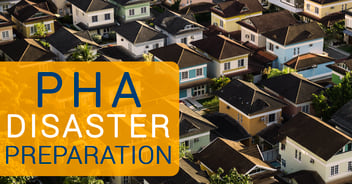How to prepare your PHA for potential disasters - Part 4

Disasters often strike unexpectedly and include a wide range of events. That’s why it’s important to be prepared before a disaster hits your community. By planning for disasters before they happen, you can help ensure your PHA has adequate resources and is ready to respond should a disaster affect your area. The information presented below aims to help your PHA create proper disaster plans and procedures as well as utilize all funding and resources that may be available during and after a disaster. This is a four part series, so be sure to read parts one, two, and three.
Putting plans into action: what happens after a disaster
In the event that a disaster occurs in your PHA’s jurisdiction there is a responsibility to provide adequate assistance to families and individuals that are affected. PHAs may also have an opportunity to utilize the available disaster recovery funds to rebuild a more resilient community and fund additional services to PHA residents.
PHA responsibilities
When a disaster strikes PHAs need to be ready to react quickly and effectively. Thankfully, if you’ve created your continuity plan and prepared for a disaster, the disaster response should go as smoothly as possible.
One of the first actions to be completed by a PHA in response to a disaster should be conducting a needs assessment. This is where you’ll start utilizing your continuity plan based on the type and scale of the disaster that is occurring or has occurred. (Remember: some events may last multiple days or weeks.) Utilizing the continuity plan, you’ll be able to quickly and effectively assess the impact the disaster had on residents, business operations, and infrastructure/ housing stock.
PHAs should utilize their resource list and begin contacting organizations and departments that may be able to assist. It is equally important that PHAs begin identifying and preparing applications for other types of state and federal funding and assistance. Remember to continue checking for notices, declarations, and other information from FEMA, HUD, and other local sources for available funding.
PHA opportunities
When disasters occur, PHAs often times have unique opportunities to not only repair and replace damaged assets, but to rebuild in a more resilient and effective way. Often times immediate needs will have costs that will need to be paid before disaster assistance funding is available. It is crucial that detailed and accurate documentation is maintained in order to be eligible for reimbursements once funds are available.
In addition to the physical repairs, disaster recovery funding also supports a variety of services. Often times federal funds have income eligibility requirements that match the PHA’s. For example, most CDBG-DR funds require that 51% of beneficiaries be under the HUD 80% income limit for the area. It is important to remember, services provided to PHA residents automatically qualify as eligible. Many jurisdictions that have received disaster recovery funds in the past have set up childcare centers, job trainings, and healthy eating/cooking classes in which all PHA residents are eligible.
When going through your potential opportunities and funding sources, be aware of special circumstances or rules specific to each funding source. Most federal funding allocations come with a unique set of rules. Waivers from certain requirements based on need and urgency may be given and sometimes additional requirements are added to funding allocations.
Putting it all together
Disasters present incredibly difficult and unforeseen challenges, but with the right preparation, many of the problems, and obstacles from disasters can be reduced. Remember these four important points for before and after the next disaster hits:
- Adequate risk assessments are crucial
- Remember to consider vulnerabilities specific to your jurisdiction
- Put together a comprehensive plan
- Ensure that your plans include not only PHA staff and resources, but incorporate other agencies and organizations
- Leverage resources currently available
- Utilizing Capital Fund Program and local government funds
- Utilize emergency funds effectively and efficiently
- Keeping adequate documentation and being prepared for the application of disaster recover funds.
- PHA residents often qualify for all types of services funded by federal disaster assistance
ICYMI, make sure to read the other posts in this series: Assessing your risks using a risk-based planning process, Continuity plans: how planning for the future impacts the present, and Coordination and partnerships, working with local resources and funding sources
About the author

With nearly a decade of experience in the affordable housing industry, James Karner has served with Nan McKay & Associates since 2012 in various roles including quality control, finance, procurement, compliance, and as a trainer. He is currently based in NMA’s Houston office, where he actively works on several CDBG-DR projects including Harris County, Texas and Joplin, Missouri.




